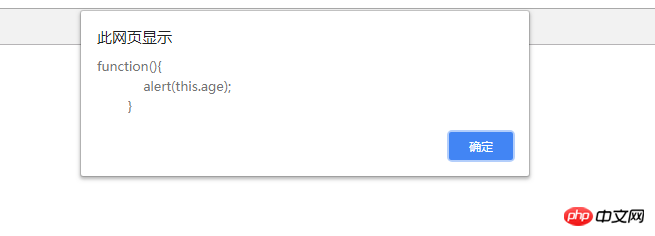Rumah >hujung hadapan web >tutorial js >JS 的面向对象中继承的那些小事(实例)
JS 的面向对象中继承的那些小事(实例)
- 青灯夜游asal
- 2018-09-15 16:17:081146semak imbas
本章给大家介绍JS 的面向对象中继承的那些小事(实例),让大家了解js中的继承特点是什么?面向对象中继承的一些小知识。有一定的参考价值,有需要的朋友可以参考一下,希望对你有所帮助。
JS中继承的特点:
1、子类继承父类;
2、子类可以用父类的方法和属性
3、子类的改变可以不影响父类
下面用一个例子来说明 JS 的继承
这段代码创建了一个父类以及它的原型,同时还创建了一个子类,并继承了父类的私有属性
<script>
//这是父类
function Father(name,age,marry){
this.name=name;
this.age=age;
this.marry=marry;
}
//父类的原型
Father.prototype.showName=function(){
alert(this.name);
}
//子类
function Son(name,age,marry,weight){
Father.call(this,name,age,marry);
this.weight=weight;
}
</script>当子类Son想继承父类的原型时,我的做法一开始是这么做的
<script>
//这是父类
function Father(name,age,marry){
this.name=name;
this.age=age;
this.marry=marry;
}
//父类的原型
Father.prototype.showName=function(){
alert(this.name);
}
//子类
function Son(name,age,marry,weight){
Father.call(this,name,age,marry);
this.weight=weight;
}
//错误的做法
Son.prototype=Father.prototype;
Son.prototype.showAge=function(){
alert(this.age);
}
var father=new Father('王大锤',30,true);
alert(father.showAge);
</script>
运行的结果可以发现,子类原型的改变影响了父类的原型,父类的原型中本来是没有showAge方法的,这就违背了前面继承的第三个特点了。
分析原因:上面代码的第20行 Son.prototype=Father.prototype;这里的 '=' 两边都是对象,那么它代表的意思就是引用,如果是引用的话,左边的对象改变,肯定会影响了右边的对象。所以才出现了子类原型的改变影响了父类的原型。
解决办法
方法一:核心思路,前面的问题不是说 '=' 是引用的关系才导致问题的嘛,那这里就保证 '=' 永远是赋值的关系,而不是引用。这里就定义一个 Clone() 方法,将父类对象拷贝给子类。
Clone() 方法里用到递归的原因是,在拷贝的过程中对象中可能嵌套对象。
<script>
//这是父类
function Father(name,age,marry){
this.name=name;
this.age=age;
this.marry=marry;
}
//父类的原型
Father.prototype.showName=function(){
alert(this.name);
}
//子类
function Son(name,age,marry,weight){
Father.call(this,name,age,marry);
this.weight=weight;
}
Son.prototype=new Clone(Father.prototype);
Son.prototype.showAge=function(){
alert(this.age);
}
var father=new Father('王大锤',30,true);
alert(father.showAge);
//通过克隆对象:核心思路是保证 '=' 是赋值的关系,而不是引用,也就是保证 '=' 的右边不是对象
function Clone(obj){
for(var i=0;i<obj.length;i++){
if(typeof(obj[key]=='object')){
this.key=new Clone(obj[key]);
}else{
this.key=obj[key];
}
}
}
</script>
方法二:代码很简单,但是很难想到,没有第一个方法那么好理解。核心思想:对象自身属性的改变,不会影响其构造函数的属性的改变。
<script>
//这是父类
function Father(name,age,marry){
this.name=name;
this.age=age;
this.marry=marry;
}
//父类的原型
Father.prototype.showName=function(){
alert(this.name);
}
//子类
function Son(name,age,marry,weight){
Father.call(this,name,age,marry);
this.weight=weight;
}
function fn(){}
fn.prototype=Father.prototype;
Son.prototype=new fn();
Son.prototype.showAge=function(){
alert(this.age);
}
var father=new Father('王大锤',30,true);
alert(father.showAge);
//通过克隆对象:核心思路是保证 '=' 是赋值的关系,而不是引用,也就是保证 '=' 的右边不是对象
// Son.prototype=new Clone(Father.prototype);
// function Clone(obj){
// for(var i=0;i<obj.length;i++){
// if(typeof(obj[key]=='object')){
// this.key=new Clone(obj[key]);
// }else{
// this.key=obj[key];
// }
// }
// }
</script>
Atas ialah kandungan terperinci JS 的面向对象中继承的那些小事(实例). Untuk maklumat lanjut, sila ikut artikel berkaitan lain di laman web China PHP!
Artikel berkaitan
Lihat lagi- Analisis mendalam bagi komponen kumpulan senarai Bootstrap
- Penjelasan terperinci tentang fungsi JavaScript kari
- Contoh lengkap penjanaan kata laluan JS dan pengesanan kekuatan (dengan muat turun kod sumber demo)
- Angularjs menyepadukan UI WeChat (weui)
- Cara cepat bertukar antara Cina Tradisional dan Cina Ringkas dengan JavaScript dan helah untuk tapak web menyokong pertukaran antara kemahiran_javascript Cina Ringkas dan Tradisional

